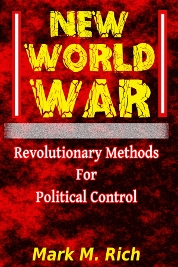Main Menu
Updates
-
Update: December 22, 2025
No Book Reviews....more - Important Updates
- Previous Updates
- Attack Log
Donations
- I accept cryptocurrency & PayPal
Available Books
New World War: Revolutionary Methods for Political Control
Dedication & Thanks
Volume I: Current Political Situation
- Overview
- Introduction
- Revolution in Warfare
- The Other World
- Dictatorship Creation
- The Groups Facilitating the Revolution
- Their Goal is Neo-Feudalism
- Problem-Reaction-Solution
- Volume I Commentary
Volume II: The New War
- The New War
- The New Enemy
- Initiatives to Remove Civil Liberties
- The Investigation
- Surveillance Technology and Methods
- Mind-Reading
- Volume II Commentary
Volume III: Weapons of The New War
- Introduction to Nonlethal Weapons
- Psychological Operations
- Introduction to Directed-Energy Weapons
- High-Powered Microwaves
- High-Powered Lasers
- Sonic Weapons
- Computer Network Operations
- Microwave Hearing
- Silent Subliminals
- Use of Citizen Informants
- Chemical and Biological
- Weather Warfare
- Miscellaneous Weapons and Tactics
- Volume III Commentary
Volume IV: The Coverup
- Volume IV Introduction
- Schizophrenia Spectrum Disorders
- Control of the Medical Industry
- Another Look at Schizophrenia
- Political Considerations
- Punitive Psychiatry in Communist Russia
- Coverup Initiatives
- Volume IV Commentary
- Conclusion
Appendix
- A Brief History of PsyOp
- Small-Scale Wars
- Nongovernmental Organizations
- Human-Computer Intelligence Network
- Electronic Tyranny
- Other Devices Connected to the GIG
- My Experience
- Sources
Other Sites
This new war is being waged against a wide range of potential threats. According to the DOD and other sources there is a new enemy that lives among the people. These threats to US national security are “complex and ill-defined” the Los Alamos National Laboratory tells us.
Regarding these new enemies, the Unconventional Warfare publication put out by the US Army in September 2008, proclaimed: “Adversaries threaten the United States throughout a complex operational environment, extending from critical regions overseas to the homeland.”
The US Army’s Strategic Studies Institute revealed in its June 15, 1998 report, Nonlethality and American Land Power that in the future, military forces will be facing opponents who were schooled in America.
“[We] must also focus on non-traditional threats at home,” mentioned the US Army War College in its April of 2002 report, Defending the Homeland. “The country must refocus and fix its attention ... on defending the homeland against a wide array of threats.”
This new enemy includes groups and individuals that are not members of a military force. “We’re not in a war against nations or big armies, we’re in a war against individuals,” proclaimed US Air Force Lt. Col. John Forsythe in a February 8, 2005 Defense Daily article.
In an article entitled, Man-Hunting, Nexus Topography, Dark Networks, and Small Worlds, which appeared in the winter, 2006 issue of Iosphere, Chief Warrant Officer 3, John R. Dodson announced: “The asymmetrical threats currently challenging U.S. national policies are not that of large standing armies. They are individuals and groups of like-minded individuals.”
The enemies are seldom states, says Toffler Associates, in a report published for the Defense Intelligence Agency. Instead, they are individuals and groups who are threats to national security and must be neutralized.
The US Army declared that this war will be waged against confirmed enemies as well as a wide range of other potential threats. The multinational force will rely heavily on the civilian population to neutralize the new enemy that lives among them. “New asymmetric threats have emerged,” announced the Department of Defense in its 2007 Annual Report. “This is an enemy that lives and hides among the civilian population,” they emphasized.
“Today’s threats” revealed Applied Energetics, a government defense contractor, “are often characterized by a non-state enemy who operates among a civilian population, in urban and congested areas.” The new enemies have been described as: insurgents, nonstate actors, asymmetric threats, irregular threats, adversaries, etc. Before we examine the new enemy in more detail, let’s have a look at the various terms used to describe them.
The February 27, 2008, US Army Field Manual Operations defines an adversary this way: “An adversary is a party acknowledged as potentially hostile to a friendly party and against which the use of force may be envisaged.” Adversaries also include members of the local populace who sympathize with the enemy. So, an adversary is someone who might be hostile or people who support them.
The US Army’s 2008 Unconventional Warfare document describes an irregular enemy in the following manner: “Irregulars, or irregular forces, are individuals or groups of individuals who are not members of a regular armed force, police, or other internal security force.” They are usually nonstate-sponsored and unconstrained by sovereign nation legalities and boundaries. Irregular enemies use unconventional or asymmetric methods to counter US advantages.
The Army says that irregular enemies include but are not limited to: specific paramilitary forces, contractors, individuals, businesses, foreign political organizations, resistance or insurgent organizations, expatriates, transnational terrorists, disillusioned transnational terrorism members, black marketers, and other social or political “undesirables.”
Nonstate actors (NSAs) are those who operate outside the control of states or governments recognized by the United Nations. They include but are not limited to, terrorists, vigilante groups, civil defense groups that are not under government control, and insurgents. Other types of NSAs are dissident armed forces, guerrillas, liberation movements, freedom fighters, rebel opposition groups, farmers’ cooperatives, local militias, and some individuals.1
In addition, all of the various organizations in the NGO category can be considered nonstate actors if they are not under state or corporate control. The RAND Corporation further describes an NSA as, “those who seek to confound people’s fundamental beliefs about the nature of their culture, society, and government.” Other adversaries, according to RAND, are “civil-society activists fighting for democracy and human rights.” RAND then links these social activists to state-run militant anarchist groups such as the black block, thereby labeling them domestic terrorists.
The book Network Centric Warfare, authored by David S. Alberts, John J. Garstka, and Frederick P. Stein, and sponsored by the Department of Defense, explains actors as: “entities that have the primary function of creating ‘value’ in the form of ‘combat power’ in the battlespace. Actors employ both traditional (lethal) and nontraditional (nonlethal) means.”
In another RAND publication released in 2005, written by Deborah G. Barger, entitled, Toward a Revolution in Intelligence Affairs, a nonstate actor is described as anyone who either acts or plans against US national security interests. Individuals using such asymmetric approaches, says RAND, will become the dominant threat to the US homeland.
The August 1, 2007, Air Force Doctrine document on irregular warfare, defines an insurgency as “an organized movement aimed at the overthrow of a constituted government through use of subversion and armed conflict.”
An insurgency is a revolutionary war, says the US Army. According to the DOD’s Dictionary of Military and Associated Terms, an insurgent is a “member of a political party who rebels against established leadership.” Insurgencies usually occur when a population is oppressed and are waged by people who orchestrate what the Air Force calls an information operation (IO), which is basically the dissemination of information. Insurgents use the news media and the internet for communicating, training, recruiting, and funding.
They also blame the ruling entity as the cause of latent widespread social, political, or even religious grievances. They may use violent or nonviolent methods to convince the population that their cause is moral. Some insurgencies are international.
Insurgents are those who try to persuade the populace to accept political change. If persuasion doesn’t work they may use intimidation, sabotage, propaganda, subversion, military force, or terror. Some insurgents attempt to organize the population into a mass movement, according to the Air Force, to separate from or overthrow the existing government.
If all of these conditions must exist in order for someone to be labeled an insurgent, then those using nonviolent methods to cause change may not be included. However, if only a few nonviolent actions, such as influencing a population, compelling a ruling party to change its behavior, spreading information (IO campaigns), or organizing a mass movement against oppression are required to meet this explanation, then those resisting tyranny may be considered insurgents.
As official sources mentioned earlier, these descriptions of the new enemy are indeed vague allowing for many possible interpretations as to who the enemy is. According to these definitions, the enemy does not necessarily use violence to promote political change. Their methods may be nonviolent.
The primary consideration here is that they are groups or individuals who are not under government control, are against the established leadership, and may influence the population to promote political change. Then there are the potential enemies who will be targeted because of an action they might take in the future. We’ll discover in the next chapter that nonviolent protesters are being labeled terrorists. These enemy variations will be referred to throughout this book as the new enemy.
RAND explains the resistance structure of the new enemy in the following way: They are formal or informal and may be large or small, with an inclusive or exclusive membership. The organizational structure is flat with no central leadership or command. The group has little or no hierarchy but may have multiple leaders.
Decisionmaking consists of a decentralized process and consensus which promotes individual initiative and autonomy. A powerful underlying set of beliefs may bond members of this structure, which allows them to share a set of common interests and objectives. This feature provides for tactical decentralization, allowing each to carry out operations as a functional unit.
Individuals in these organizations may further their political ideas by “wrapping themselves in nationalism,” and acting like local Robin Hoods, who seek to “influence, if not control, their governments and their foreign and domestic policies,” says RAND. “They engage in systematic activities to evade government controls.”
This is an interesting statement by RAND, particularly because it was believed that the government existed to serve the people, not to control them. Other US government sources describe similar structures for these “insurgent groups” in their irregular warfare publications. According to these sources, the insurgent groups will be masters of NCW and will function more like an extended family than a military.
“The methods of warfare employed by our new adversaries,” says the DOD, “seek to destabilize a state and capitalize on this instability.” According to the US Army, this is accomplished using methods that appear to be peaceful and routine, but will be used to damage the global distribution of power.
While the adversary leadership structure and tactics that RAND and the US military just explained is somewhat vague, it could easily be interpreted to include those used by nonviolent groups in the past to resist tyranny. Such movements have been led by committees or groups of leaders.
For instance, Mohandas K. Gandhi and the Indian National Congress used such tactics against the British Crown in South Africa and India. They were used by Dr. Martin Luther King Jr. in the American south. Many other nonviolent groups worldwide have used these methods to educate and mobilize their fellow citizens in order to resist an occupying tyrannical force or to expose a social evil.
These information wars, the Army tells us in its Unconventional Warfare manual, have been waged in the past by individuals and groups against tyrannical governments. “Combined with political purpose,” it explained, “political warriors have sought to resist the occupier, or subvert and overthrow the oppressor.”
In its May of 2003 Deterring and Responding to Asymmetrical Threats article, the School of Advanced Military Studies of the United States Army Command and General Staff College announced that the US will most likely face regional threats that will challenge it through asymmetric approaches. These approaches will include area denial strategies, economic competition, and information warfare. And the enemy will be using “information attacks” and “direct action attacks.”
The new enemies are those using information attacks to strike against the large corporate trade or political institutions, according RAND. Most are nonstate actors. Such an adversary, says RAND, will not be focusing its attacks at the military, but instead at the core of the international system, particularly if it is at odds with their deeply held cultural, religious, or ideological beliefs.
“The most pressing threats of the new security environment are violent reactions to the world’s movement toward a single international system,” revealed the Department of Defense in its November 2002 report, Effects Based Operations: Applying Network Centric Warfare in Peace, Crisis, and War. “The overt hostility toward what is perceived to be a heavily American globalization,” it added, “make it plain that this evolution will be neither easy nor without significant peril.”
Likewise, the CFR had this to say regarding the resisters of this global movement: “In the transformation of a process … there are often elements less subject to evolution.” According to the CFR these evolutionary resisters are using a dispersed resistance movement that is concealed within the civilian population. They suggest that the US military change its tactics to neutralize these resisters.
“As globalization increases world integration,” explained the US Army, “the scope of threats to US security and public safety becomes more global.” “The enemies of integration,” advised Toffler Associates, “pose the most serious threat to world order.” The security forces, therefore, will be increasingly locating and neutralizing these threats to globalization, according to the US Army.
So, these government think tank and military reports are telling us that the new enemy includes groups and individuals with particular political views who are standing in the way of human development as our society evolves into a global civilization.
These new enemies exist all over the planet. According to the US military and government defense contractors, they use computers, the internet, fax machines, cell phones and public media to convey their messages. The internet is used for communications, propaganda, funding, and training, they tell us.
The enemies use their position within a state’s military, political, or social structure to further their objectives. They use information operations to influence state forces within the population. In various publications, the act of transmitting information has been called netwar, information operations, information warfare, information attacks, etc. According to the RAND Corporation, most of this netwar is waged through the media, including newspapers, magazines, TV, faxes, and particularly the internet.
Information attacks, according an article called, A Theory of Information Warfare, that appeared in the spring, 1995 issue of Airpower Journal, are attacks aimed at the knowledge or belief systems of adversaries. Information operations (IO) have also been called cyberwar, information warfare (infowar), network centric warfare (netwar, NCW), and command and control warfare (C2W).
The DOD describes IO as: “The integrated employment of the core capabilities of electronic warfare, computer network operations, psychological operations, military deception, and operations security, in concert with specified supporting and related capabilities, to influence, disrupt, corrupt or usurp adversarial human and automated decision making while protecting our own.”
Because there is no reference to the use of IO by enemies in this definition, when an enemy is said to be engaging in IO, it can be considered that their activities meet this definition. However, the context with which IO, and its related terms have been used by official sources suggests that the act of simply conveying information, alone, can be described as an IO.
The following definition of infowar appeared in a 1999 edition of Air and Space Power Journal, in an articled called What is Information Warfare?: “Information Warfare is any action to deny, exploit, corrupt or destroy the enemy’s information and its functions; protecting ourselves against those actions and exploiting our own military information functions.” So, information attacks, information operations, command and control warfare, information war, etc., are all basically the same.2
The new war is one fought for political purposes. It is done for the support and influence of the population. “Its battles are fought amongst the people,” the US Marine Corps tells us, “and its outcomes are determined by the perceptions and support of the people.”
What makes this new type of warfare different, says the DOD, is the focus of its operations, which is a relevant population, as well as its purpose, which is to gain or maintain control or influence over, and support of, that relevant population. The focus is on the legitimacy of a political authority to control or influence a population.
Because the multinational force must be perceived as legitimate by the civilians whom it relies on, information is a devastating weapon. The ideas which influence a person’s perception are transmitted by information. “Information warfare techniques,” explained Steven J. Lambakis in Joint Force Quarterly’s Reconsidering Asymmetric Warfare article, “pose asymmetric threats to the United States and its interests.” This new war is a “war of ideas and perception,” as described by the US Marine Corps.
The book, The Information Revolution and National Security, published by the Strategic Studies Institute describes information warfare as a type of virus or cognitive agent that infects people with a unit of information and continues to create copies of it in the minds of people. The SSI portrays this as a destructive social process, which damages existing political structures by disrupting an establishment’s methods to achieve political consensus (control). The use of these viruses, it explains, offsets the physical use of force, moving off the high-tech battlefield and into the human realm.
During a discussion called Strategic Communications—The Information Battlefield, at the 2007 Proceedings of the Combat Studies Institute Military History Symposium, Lieutenant General William B. Caldwell declared: “Essentially, the survival of these non-state actors depends on having a fertile ground of accepting populations to sow their seeds of discontent and lies.”
“The target of information warfare, then, is the human mind,” suggested Professor George J. Stein, in an Airpower Journal article entitled, Information Warfare. “The battle,” he emphasized, “remains the battle for the mind.” The US Marine Corps announced: “The credibility and perceived legitimacy of the US effort or the cause we support must never be put at risk by deceptive information operations.”
Future enemies will be striking the American homeland using “information attacks,” declared Steven Metz and Douglas V. Johnson in their 2001 article Asymmetry and US Military Strategy. The DOD’s Network Centric Warfare report further states that nonstate actors use dangerous information warfare as instruments of power. What all of this means is that this is an information war.
Endnotes
1 There are some conflicting definitions of nonstate actors. For instance, James Madison University's article Non-State Actors and Their Significance does not include farmers' cooperatives as NSAs, but the online encyclopedia, Wikipedia, does. See Non-state Actor/Entity at wikipedia.org/wiki/Non-state_actor.
2 The Naval Law Review's 1998 report, A Primer on the Employment of Non-Lethal Weapons by Lieutenant Colonel James C. Duncan, says C2 warfare is a component of IW. The, What is Information Warfare? article published by Air and Space Power Journal on November 2, 1999 says that information warfare (IW), information operations (IO), and command and control warfare (C2W) are the same.






